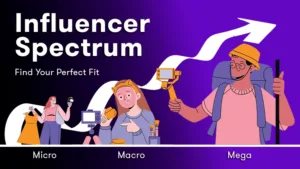The Influencer Spectrum: Finding The Best Fit For Your Marketing Requirements
With over 7 years of e-commerce experience, Agne has mastered the balance of creativity and performance. From guiding social media strategies to crafting high-converting ads, she’s all about results.

Influencers come in various shapes and sizes. Some are ideal for startups while others appeal to the biggest brands.
As such, influencer marketing is now a $21 billion industry and growing fast. More people are moving into it daily and helping prospects along their buyer journeys. It’s a marketer’s dream come true.
But do you really understand how the influencer world works? If not, this guide is for you. It explores the various influencer types across the spectrum, including the top influencer categories and how to choose the right one for your business.
What Are Influencers And Why Do They Matter For Marketers?
Influencers are social media personalities who have “influence” over their audiences. Many talk about lifestyle, travel, beauty, fitness, and gaming, but they can cover any topic, making them valuable business collaborators.
For example:
- An fishing supplies company could work with an influencer who publishes angling content
- A car dealership could work with an influencer who reviews cars
- A desktop computer manufacturer could partner with an electronics hardware channel
The primary role of influencers in marketing is to introduce brands to new audiences and build trust. Popular social media personalities have loyal followers who trust them to provide sound advice on what they should buy.
Working with different types of social media influencers can help with various stages of the sales funnel. Simply advertising on their channels can introduce audiences to your branding and what you do, even if they aren’t ready to buy from you yet.
Note that influencers and creators are not the same. Influencers can land brand partnerships (because of their style or approach) while creators are anyone who generates digital content.
Companies can be willing to work with edgier content creators, but not always. That’s why most influencers stick to a middle-of-the-road-type approach, allowing them to appeal to audiences without rocking the boat too much.
Different Types Of Influencers
When it comes to influencers, there are no hard-and-fast categories. However, it can help your business to categorize them so you know who to target.
Experts typically categorize influencers into the following categories based on follower count:
Mega-Influencers
Mega influencers are at the top of the pile because of their sheer size. These personalities have more than 1 million followers, with many boasting over 50 million.
Because of this, mega influencers like Cristiano Ronaldo and Jamie Oliver can charge the biggest bucks for ad placements. Most only work with global brands that can afford to use them to reach a wider audience.
For example, singer Selena Gomez charges over $2.5 million per branded post on Instagram while Taylor Swift can ask for $1.6 million per post to get marketing content in front of her 280 million-strong followership.
Therefore, you could use a mega influencer to:
- Launch a global product
- Create international awareness for your brand
- Promote an industry event with a broad reach
- Receive a notable brand endorsement from a top personality in your industry
- Manage a crisis that might threaten the existence of your firm
Macro-Influencers
Macro influencers represent the next largest category of influencers. These personalities have between 100,000 and 1 million followers and mostly see social media as their full-time job (though some still work in other professions).
Macro influencers offer opportunities for brands to communicate with large audiences more precisely than mega influencers but without such extreme reach. The people following these personalities are more likely to be interested in their specific topic, which is ideal for buyer persona targeting.
Of course, macro-influencers are still wildly successful and ask for larger budgets. But some companies might find them better value for money than mega influencers.
Consider using a macro influencer to:
- Reach a specific audience in your niche
- Increase brand awareness among new overlapping audiences interested in your vertical
- Engage in brand collaborations and co-creations
- Launch regional campaigns (i.e. Japan or North America)
- Publish product demonstrations and reviews
Micro-Influencers
Micro-influencers have between 10,000 and 100,000 followers and the advantage of being more cost-effective than their larger rivals while maintaining significant authority in their niche. Furthermore, they deeply understand who their audience is and what they want, so, if you can build a collaboration with them, you can often target content more effectively.
Work with a micro-influencer to:
- Launch highly targeted campaigns at a specific niche
- Build more credibility with established customers
- Increase audience engagement and build a core following of support
- Gain authentic reviews and testimonials for customer trust
- Create ongoing relationships with partners who can promote your brand
(Sometimes you will come across the term “mid influencers.” These straddle the boundary between micro and macro and often have 50,000 to 250,000 followers. Brands use these for a balance between relevance and audience size).
Nano-Influencers
Nano influencers have the smallest audiences (less than 10,000 followers) and their value to brands comes from their cost-effectiveness and highly engaged and loyal audiences. Followers often hang on every word they say, making them highly influential for companies selling personalized or niche products.
Of course, the downside is their small audience size. Most companies must work with dozens of niche nano influencers to get their message out.
In summary, you should work with a nano-influencer to:
- Build awareness with the grassroots community
- Be more interactions with customers that make them feel a part of your brand
- Improve reach even if you have a limited budget
- Target a niche or highly-specific audience that isn’t available elsewhere
- Get immediate feedback from audiences using free samples or trials
Companies rarely work with influencers with fewer than 1,000 followers. The economic incentives just aren’t there. However, you can sometimes approach smaller accounts if you see potential in them or want to partner for the long term.
KOLs – Key Opinion Leaders
KOLs are their own subset of influencers. Not defined by the number of followers or views and instead based on their topical expertise. Here you will encounter medical professionals, scientists, and similar types of people educating their audience.
Niche Influencers: Types And Categories
Social media marketers also categorize influencers by topic. And given the complexity of our world, there are a lot of these!
Gamers
Gamers are among the most popular influencer niches out there. Accounts like Mr. Beast offer game reviews, tutorials, walkthroughs, montages, and challenges to get their audiences pumped about their content.
These accounts are ideal for anyone selling games, peripherals, consoles, and gaming chairs. Brands that target the men’s market, like Dollar Shave Club, can also see success on these channels.
Sports And Fitness
Sports and fitness is another popular category. Influencers in this segment, like Jordan Yeoh, cover topics like bodybuilding, CrossFit, gym, running, yoga and weight loss. Marketers from numerous industries, including supplement and fitness equipment manufacturers, can often find opportunities to work with them.
Family And Parenting
You also find numerous influencers in the family and parenting segments, like The Weenie Family. These channels provide advice to new and experienced parents and depict family life.
Parenting vlogs are a goldmine for brands selling everything from diapers to vacations. These channels present unique opportunities to connect with moms and dads looking for ideas to improve their lives at home.
Fashion
Fashion influencers, like Vivacious Honey (Vanessa Chen), also communicate with audiences some marketers want to target. These social media personalities are ideal for clothing and accessory brands looking to boost their reach. Influencers are often excited to try and review new products, particularly if they represent a departure from the norm.
Beauty
Like fashion, beauty influencers are also popular on social media. Audiences want experts who can guide them on how to do their makeup and improve their look.
For example, Meredith Duxbury (who has over 1.39 million subscribers) covers all sorts of topics from makeup tutorials to manicures. Brands love using her to review their products and show audiences how they look on her.
Food
iframe
Food is another significant category worth exploring as a brand. It caters to various companies in the catering industry including restaurants, bars, and online specialty food retailers.
Travel
Lastly, travel influencers are another niche catering to the hospitality, photography, and travel accessories industries. Content usually takes the form of vlogs of their adventures, exploring distant parts of the globe and reporting back on what they loved to their audiences.
Top Flight Family is a good example of a travel vlog in action. The channel once covered adventures to tropical destinations while posting advice on how to look stylish along the way.
Local Influencers
Local influencers differ from the above because they can belong to any niche but only appeal to a regional audience. For example, you might leverage their services as a local kebab shop or hair stylist.
Interestingly, most local influencers are also micro or nano influencers – they don’t have large global audiences. But they can be tricky to find because of this.
One method is to search them by platform and location using advanced search tools. Third-party vendors offer products that allow brands to discover new influencers in their areas and niches. You can also look for them on Google or network with the local community (to see who people like in the area).
How To Choose the Right Influencer (And Avoid Costly Mistakes)
As we have seen, there are numerous influencer categories, but how do you choose the right ones? That’s where this section can help. We look at some of the factors to consider before making a decision.
Audience Alignment
The number one consideration should be audience alignment. Does your influencer speak to the same sort of people you do?
If you aren’t sure, you can sometimes ask the influencer to reveal their audience profile and see if it matches your buyer persona. Other times, it is obvious from their content and comments. You can check who engages with their material and ask whether it is similar to those buying from you.
Engagement Rates
You also want to consider engagement rates – the quantity of likes, shares, and comments the influencer generates. These can vary wildly, so choose your influencer carefully.
Engagement rates decline on larger accounts, so always consider this factor when choosing a partner. Average engagement rates on Instagram across all influencers are 2.19%. But that figure is much higher for nano influencers (around 3 to 7%) and lower for mega influencers (1% to 2%).
It’s okay if the engagement rate is on the low side as long as the influencer’s fee reflects this. Pick the one with the higher engagement rate if two social media personalities have the same reach and content.
Content Style
Lastly, the influencer’s content style matters when picking who to work with. You want a partner who reflects your brand’s values and mission. What they do should also align with your marketing efforts.
For example, if you want an influencer to review a new product, work with one who does it regularly. Likewise, if you need to do a branded collaboration, find an influencer with a history of corporate relationships.
Tools And Methods To Identify The Best Influencers For Your Brand
Finding the best influencers for your brand is tricky, even if you know exactly what you need to look for. Fortunately, various tools are available to make your life more straightforward.
Billo App is an excellent option for user-generated content (UGC) and marketing. It offers access to a diverse pool of creators, letting you find influencers who match your niche and audience.
What’s nice about the Billo App is the ability to search for creators based on criteria such as location, demographics, and content style. These features make it straightforward to discover influencers who align with what you do and want to achieve.
Billo also focuses mostly on video content – the most effective and engaging online. It looks for influencers who can talk about your products and get people enthusiastic about them. You can even specify the content quality you want to ensure your branding remains consistent (and isn’t damaged by an influencer collaboration).
The scalability of Billo is also useful. The platform lets you increase your influencer marketing effort by accessing the creators you need all in one place. Social media personalities who fit your branding best are easy to find. You don’t have to make do with the first option!
Creative Manager
With over 7 years of e-commerce experience, Agne has mastered the balance of creativity and performance. From guiding social media strategies to crafting high-converting ads, she’s all about results.

Authentic creator videos, powered by real performance data
22,000+ brands use Billo to turn UGC into high-ROAS video ads.
How to Find Micro Influencers for Your Brand’s...
Looking for micro influencers for your brand’s next campaign? You’re [...]...
Read full articleBeyond the Ad: Influencer Marketing Services for...
Sponsored posts alone won’t cut it in 2025. Global influencer-marketing [...]...
Read full articleTop 20 TikTok Influencers for 2025
Having rapidly evolved from a short-form video app predominantly used [...]...
Read full article



